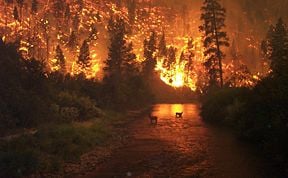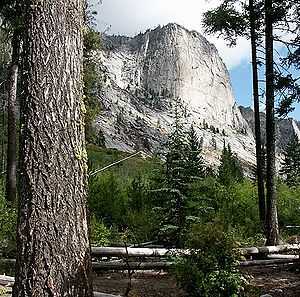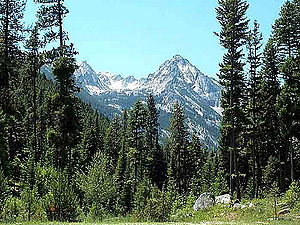Bitterroot National Forest
| Bitterroot National Forest | |
|---|---|
| IUCN Category VI (Managed Resource Protected Area) | |
| | |
| Location: | Ravalli and Missoula counties in Montana; Idaho County in Idaho, USA |
| Nearest city: | Missoula, MT |
| Area: | 1.6 million acres (6,500 km²) |
| Established: | 1907 |
| Governing body: | U.S. Forest Service |
Bitterroot National Forest comprises 1.6 million acres (6,500 km²) in west-central Montana and eastern Idaho, of the United States.
Founded in 1898, the forest is located in the Bitterroot and the Sapphire mountain ranges with elevations ranging from 2,200 feet (650 m) along the Salmon River in Idaho to 10,157-foot (3,100-m) Trapper Peak. Roughly half the forest (743,000 acres, 3,000 km²) is included in three distinct wilderness areas (the Anaconda-Pintler, Selway-Bitterroot, and Frank Church River of No Return Wildernesses) that make up the largest expanse of continuous pristine wilderness in the lower 48 states. The distinction is that in wilderness areas, no roads, logging, mining, or other construction is permitted and all access must be done either on foot or horseback; even bicycles are not permitted. Hunting, however, is allowed forest-wide, including wilderness areas.
Geography
The forest headquarters is located in Hamilton, Montana. The largest nearby city is Missoula, Montana. U.S. Highway 93 passes through portions of the forest. Scenic Blodgett Canyon is but one of more than two dozen steep canyons deeply carved into the eastern flanks of the Bitterroot Range in the forest.
Starting from a group of peaks at over 8,500 feet (2,590 m) along the Idaho/Montana border, the canyon steeply drops to Blodgett Lake at 6,800 feet (2,070 m). After running northeast for about a mile, it turns due east and descends for a total of about 12 miles (19 km) to the Bitterroot Valley. A trailhead is located at the mouth of the canyon, just west of the community of Hamilton.
The vertical canyon walls in the lower section rise over 2,000 feet (610 m) above Blodgett Creek. Printz Ridge and Mill Point make up the northern wall, while Canyon Peak and Romney Ridge contribute to the southern wall. The upper (eastern) section of the canyon is part of the Selway-Bitterroot Wilderness Area. In the year 2000, the forest in the lower section of Blodgett Canyon was extensively burned.
The canyons in this region were carved out by ice age glaciers, which left behind U-shaped valleys, moraines, hanging valleys, and steeply carved granite mountains, cliffs, and cirques, all of which are visible within Blodgett Canyon.
Flora
The forest is a combination of both grasslands and forested zones. Grazing rights are leased to private landowners in the lower elevations where grasses and shrublands are dominant. Higher up, Douglas fir, larch, and lodgepole pine slowly give way to Engelmann spruce and whitebark pine as the altitude increases. Above the treeline at 8,000 feet (2,400 m) the trees abruptly end and alpine flowers and grasses are found.
The bitterroot (Lewisia rediviva) for which the forest is named is a small, low, pink flower with a yellow center. It is the state flower of Montana. The plant is a low-growing perennial plant. A single flower appears on each stem, ranging in color from whitish to deep pink or rose, during May and June. The roots were consumed by local Native American tribes such as the Shoshone and the Flathead Indians as an infrequent delicacy.
Three major geographic features, the Bitterroot Mountains (running north-south and forming the divide between Idaho and Montana), the Bitterroot Valley, and the Bitterroot River (which flows south-north, terminating in the Clark Fork river in the city of Missoula), owe the origins of their names to this flower. The Lemhi Shoshone believed the small red core found in the upper taproot had special powers, notably being able to stop a bear attack.
Fauna
A small grizzly bear population is located in the wilderness zones of the forest with black bear, mountain goat, bighorn sheep, elk, and moose found forestwide. An active effort to reintroduce the grizzly bear to the region concluded in 2000 with a plan to release 25 bears into the wilderness zones over a five-year period beginning in 2003.
Recreation uses
There are 1,600 miles (2,500 km) of trails and 18 improved campgrounds within the forest. Outstanding fishing is found in the dozens of rivers, streams, and lakes. Other water activities that can be enjoyed are boating, rafting, and water-skiing. Lake Como, constructed in 1905 to provide late-season irrigation for the Bitterroot Valley, provides a beach for swimming. Winter recreation includes downhill and cross-country skiing, snowmobiling, and snowshoeing.
History
The Bitterroot Salish, Upper Pend d’Oreille, and the Kootenai lived in the region. The territories of these three tribes covered all of western Montana and extended into parts of Idaho, British Columbia, and Wyoming.
The Lewis and Clark Expedition passed through parts of what are now forest lands in 1805. After the discovery of gold in Idaho and then Montana in the 1860s, numerous mining towns were built, some of which today are ghost towns. The Nez Perce National Historic Trail passes through a portion of the forest, following the route of the retreating Nez Perce on their historic path that led from Idaho to north-central Montana in 1877. Heavy logging and other resource depletion beginning in the 1880s led conservationists to push for preservation of the forest.
The Bitter Root Forest Reserve was established by the General Land Office on March 1, 1898, with 4,147,200 acres (16,783 km²). It was transferred to the Forest Service in 1906. On July 1, 1908, the name was changed to Bitterroot National Forest, with lands added from Big Hole National Forest and Hell Gate National Forest. Other lands were transferred from Biterroot to Beaverhead, Clearwater, Nez Perce and Salmon National Forests. On October 29, 1934, part of Selway National Forest was added.
ReferencesISBN links support NWE through referral fees
External links
- Bitterroot National Forest - U.S. Forest Service
- USGS Gird Point (MT) Topo Map - TopoQuest.com
- Bitterroot National Forest Recreation
Credits
New World Encyclopedia writers and editors rewrote and completed the Wikipedia article in accordance with New World Encyclopedia standards. This article abides by terms of the Creative Commons CC-by-sa 3.0 License (CC-by-sa), which may be used and disseminated with proper attribution. Credit is due under the terms of this license that can reference both the New World Encyclopedia contributors and the selfless volunteer contributors of the Wikimedia Foundation. To cite this article click here for a list of acceptable citing formats.The history of earlier contributions by wikipedians is accessible to researchers here:
The history of this article since it was imported to New World Encyclopedia:
Note: Some restrictions may apply to use of individual images which are separately licensed.




